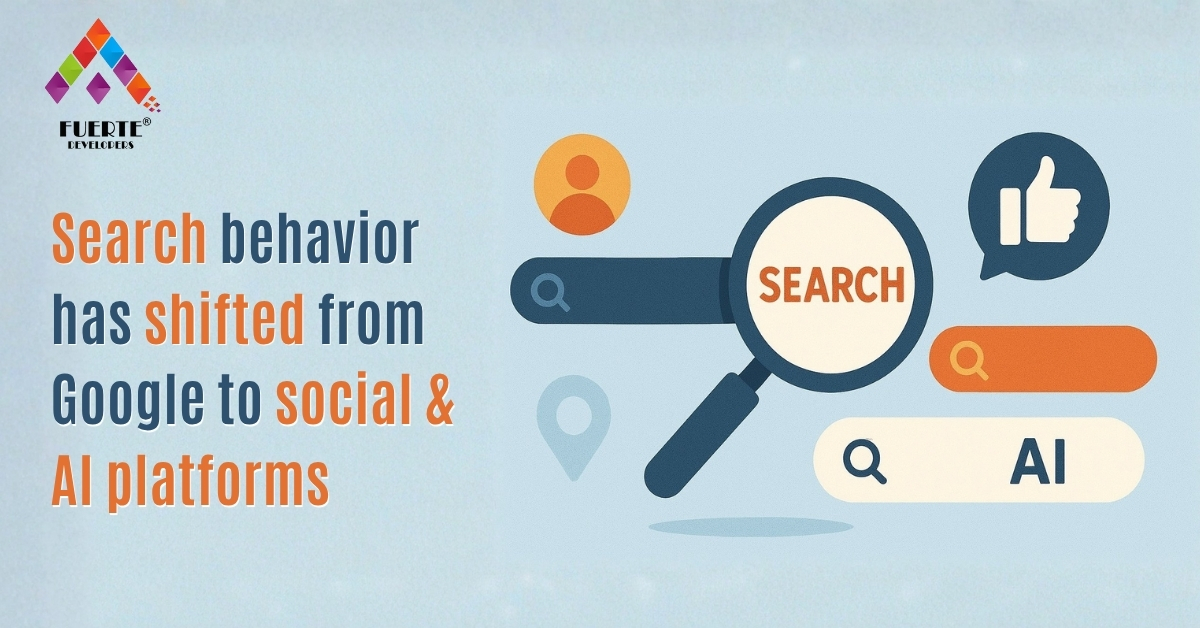In 2020, Google Search was king for finding answers. Got a question? You’d just Google it. For more than ten years, Google was how most people got around online. Need a coffee shop? Want to know about a phone? Looking for a recipe? Google was the place to start.
But things changed a lot by 2025. How people search for stuff and what they trust shifted a ton. Now, people don’t just use Google. They find stuff through Instagram, TikTok, and YouTube. Or they ask AI like ChatGPT and Gemini for quick answers.
For Example-
In 2020, finding a good restaurant was easy. You just typed “best restaurants near me” into Google and checked out the search results.
Now, things have changed. People watch food videos on Instagram & YouTube, use ChatGPT for advice, or read customer reviews on social media. Instead of reading long articles, they want short videos, personal stories, and real opinions to help them decide.
This change isn’t just about new tech. It’s about how people like to get information. Searching has changed from simple typing to a more visual, interactive experience.
Let’s explore thoroughly why this shift happened, what it means for users and businesses, and how marketers can adapt to this new era of social and AI-powered discovery.
The Evolution of Search Behavior
How we search for things online has changed as technology has gotten better.
- 2000–2010: Google was king. Websites, blogs, and keywords were what mattered.
- 2010–2020: YouTube, Quora, and review sites gave search a more human touch.
- 2020–2025: Big change! Now, people want answers that are visual, chatty, and up-to-the-minute.
This isn’t just a passing fad; it’s a real change in how we act online.
Surveys from social networks show that over 40% of Gen Z would rather search on TikTok or Instagram than on Google. The reason? They find what they’re looking for feels real, looks good, and is made just for them.
Social Media: The New Search Engine
Search isn’t just text anymore. Now, it’s visual, quick, and led by creators.
Here’s why social media is the new Google for the younger generation:
1. The Shift from Text Search to Visual Discovery
When people want to find a café, hairstyle, or outfit, they want to see options. That’s why Instagram Reels, Pinterest, and TikTok are so popular. People use hashtags like #DelhiCafes, #BestPhone2025, or #MakeupTutorial. They quickly get visuals, trends, and recommendations from real people.
2. Authenticity Wins Over Authority
Google’s search results often favor big websites or content that’s good at SEO. Social platforms show real people sharing real experiences. This feels more trustworthy, mainly when looking for lifestyle, food, travel, or product info.
3. People Answer Questions
Social search is not just about finding stuff; it’s about joining chats. People comment, share, and talk about things, building groups around interests. Google can’t do that.
How AI Changed Search: From Keywords to Conversations
During this time social platforms focus on visuals, and AI tools focus on understanding. Like ChatGPT, Gemini, Copilot, and Perplexity have changed how we look for information.
Now users ask, “I’m planning a 5-day Bali trip in June; what should I do, and where should I stay?”
The AI responds with a complete, contextual itinerary, not just links.
Why People Prefer AI Search:
- Personalized responses: Tailored to the user’s intent.
- Time-saving: No need to open 10 tabs.
- Conversational: Feels like talking to an expert friend.
- Ad-free (mostly): No clutter or distractions.
AI search represents the next leap in how we consume information, from searching to conversing.
The Psychology Behind the Shift
Moving away from Google toward social media and AI isn’t just about using new tools. It reflects changes in how people think, feel, and find information now. We’re in an age where people want answers fast. They don’t want to look through many sites or read long texts. They want content that’s quick, visual, reliable, personal, and simple to understand.
Here’s why this change is happening:
- Instant gratification: No one wants to scroll through long blogs or 10-page search results.
- Visual preference: The brain processes visuals 60,000x faster than text.
- Trust in peers: Users trust other users (creators) more than brands or faceless articles.
- Convenience: AI tools summarize information instantly, and no effort is needed.
How Google Is Adapting to the New Search Era
Google clearly understands that the way people search is changing, and it’s not staying behind. As social media and AI tools reshape how users find information, Google is actively reinventing itself to stay at the center of the digital world.
Some key adaptations include:
- Search Generative Experience (SGE): One of its biggest steps forward is the introduction of Search Generative Experience. a feature that uses AI to generate quick, summarized answers directly at the top of search results. Instead of showing users a list of blue links, Google now provides a smart overview that feels more conversational and context-aware.
- Visual search: Google is also putting a lot of effort into visual search. Google Lens lets you search with pictures instead of words, and YouTube Shorts are showing up in search results to compete with TikTok and Instagram.
- Personalization: Google is using AI to change results based on what you want, your search history, and how you browse. The goal is to make every search feel personal and relevant.
However, despite all these advancements, Google’s biggest challenge is staying authentic. Many users now see AI tools and social platforms as more personal and “human,” while Google still struggles with being viewed as too algorithmic and ad-focused.
Even so, Google isn’t giving up. With AI and new ways of showing results, Google is trying to mix the old search experience with the way people are finding things now.
What This Means for Brands and Businesses
This change means marketers need to rethink their plans. You can’t just depend on Google to get noticed.
Here’s how to adapt:
1. Invest in Social Search Optimization (SSO)
Like with getting found on Google, work on getting seen on places like Instagram, TikTok, and YouTube.
- Use the right hashtags.
- Write video titles and descriptions that people can search.
- Make useful, short posts.
2. Create AI-Friendly Content
AI tools summarize the web, so structure your content to be easily understood by them.
- Use clear headings, FAQs, and short answers.
- Be factual and use a friendly tone.
- Update content frequently to stay relevant.
3. Mix Google, Social Media, and AI
Your online plan should now include Google, social media, and AI all working together.
For example:
- Use Google for detailed info.
- Use Instagram/TikTok for catching people’s eye.
- Use tools like ChatGPT for answering questions.
- Being seen everywhere is the new way to get found online.
4. Use Content from Your Fans
Ask customers to post reviews, videos, and their experiences. This kind of content does well in social search and when AI makes summaries.
The Future of Search: It’s All About Finding, Not Just Data
We’re moving into a time where finding things is a whole new ballgame. Searching isn’t just about digging up info anymore. It’s about getting into content that feels real and alive.
AI is going to keep getting better, social media is going to keep getting personal, and people are going to want results faster and in a more visual way.
What’s coming soon:
- Video will take over search.
- AI summaries will be used instead of snippets.
- Small influencers will have an impact on what we trust in search results.
- Talking and showing will be more used than typing for searches.
Final Thoughts
The change from Google to social media and AI isn’t a bad thing. It’s just how things are changing. People still search, but they do it a bit differently now. They scroll, they ask questions, and they pay attention. The ones who win in this world will be the ones who change their plans from just focusing on words to paying attention to who they’re trying to reach. So, if you’re still only making changes for Google, it’s time to think bigger. The direction of search is no longer typed. It’s said, watched, and felt.







